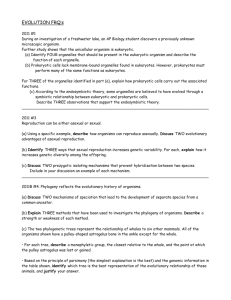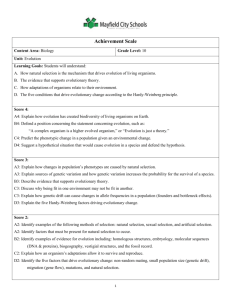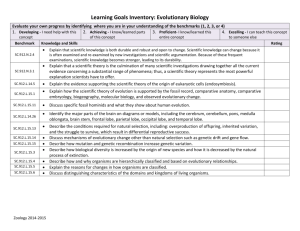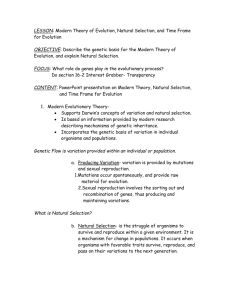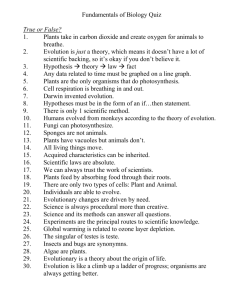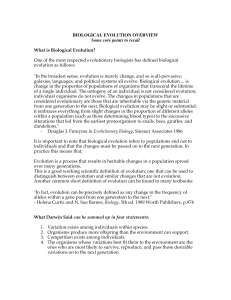Past Evolution FRQ's - local.brookings.k12.sd.us
advertisement
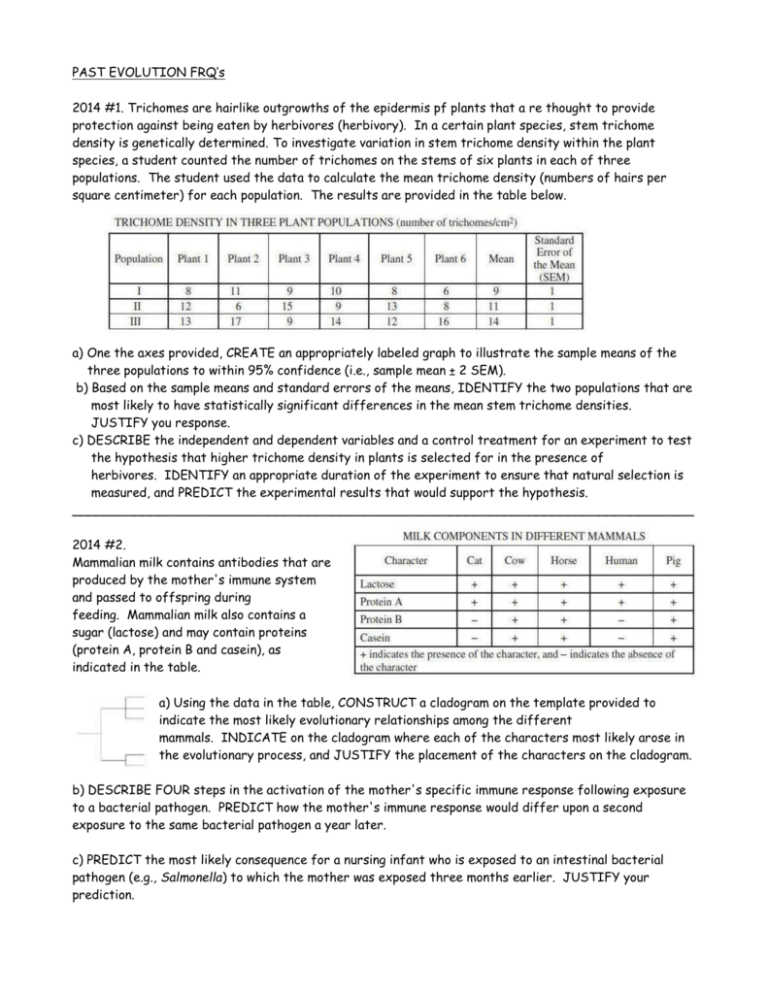
PAST EVOLUTION FRQ’s 2014 #1. Trichomes are hairlike outgrowths of the epidermis pf plants that a re thought to provide protection against being eaten by herbivores (herbivory). In a certain plant species, stem trichome density is genetically determined. To investigate variation in stem trichome density within the plant species, a student counted the number of trichomes on the stems of six plants in each of three populations. The student used the data to calculate the mean trichome density (numbers of hairs per square centimeter) for each population. The results are provided in the table below. a) One the axes provided, CREATE an appropriately labeled graph to illustrate the sample means of the three populations to within 95% confidence (i.e., sample mean ± 2 SEM). b) Based on the sample means and standard errors of the means, IDENTIFY the two populations that are most likely to have statistically significant differences in the mean stem trichome densities. JUSTIFY you response. c) DESCRIBE the independent and dependent variables and a control treatment for an experiment to test the hypothesis that higher trichome density in plants is selected for in the presence of herbivores. IDENTIFY an appropriate duration of the experiment to ensure that natural selection is measured, and PREDICT the experimental results that would support the hypothesis. _______________________________________________________________________________ 2014 #2. Mammalian milk contains antibodies that are produced by the mother's immune system and passed to offspring during feeding. Mammalian milk also contains a sugar (lactose) and may contain proteins (protein A, protein B and casein), as indicated in the table. a) Using the data in the table, CONSTRUCT a cladogram on the template provided to indicate the most likely evolutionary relationships among the different mammals. INDICATE on the cladogram where each of the characters most likely arose in the evolutionary process, and JUSTIFY the placement of the characters on the cladogram. b) DESCRIBE FOUR steps in the activation of the mother's specific immune response following exposure to a bacterial pathogen. PREDICT how the mother's immune response would differ upon a second exposure to the same bacterial pathogen a year later. c) PREDICT the most likely consequence for a nursing infant who is exposed to an intestinal bacterial pathogen (e.g., Salmonella) to which the mother was exposed three months earlier. JUSTIFY your prediction. 2014 #4. Adult male guppies (Poecilia reticulata) exhibit genetically determined spots, while juvenile and adult female guppies lack spots. In a student of selection, male and females guppies from genetically diverse populations were collected from different mountain streams and placed together in an isolated environment containing no predators. The study population was maintained for several generations in the isolated area before being separated into two groups. One group was moved to an artificial pond containing a fish predator, while a second group was moved to an artificial pond containing no predators. The two groups went through several generations in their new environments. At different times during the experiment, the mean number of spots per adult male guppy was determined as shown in the figure below. Vertical bars in the figure represent two standard errors of the mean (SEM) a) DESCRIBE the change in genetic variation in the population between 0 and 6 months and PROVIDE reasoning for your description based on the means and SEM. b) PROPOSE one type of mating behavior that could have resulted in the observed change in the number of spots per adult male guppy between 6 and 30 months in the absence of the predator. c) PROPOSE an evolutionary mechanism that explains the change in average number of spots between 6 and 20 months in the presence of the predator. ___________________________________ __________________________________________ 2013 #3 Fossils of lobe-finned fishes, which are ancestors of amphibians, are found in rocks that are at least 380 million years old. Fossils of the oldest amphibian-like vertebrate animals with true legs and lungs are found in rocks that are approximately 363 million years old. Three samples of rocks are available that might contain fossils of a transitional species between lobefinned fishes and amphibians: one rock sample that is 350 million years old, one that is 370 million years old, and one that is 390 million years old. a) SELECT the most appropriate sample of rocks in which to search for a transitional species between lobe-finned fishes and amphibians. JUSTIFY your selection. b) DESCRIBE TWO pieces of evidence provided by fossils of a transitional species that would support a hypothesis that amphibians evolved from lobe-finned fish. 2013 #2 An absorption spectrum indicates the relative amount of light absorbed across a range of wavelengths. The graphs above represent the absorption spectra of individual pigments isolated from two different organisms. One of the pigments is chlorophyll a, commonly found in green plants. The other pigment is bacteriorhodopsin, commonly found in purple photosynthetic bacteria. The table above shows approximate ranges of wavelengths of different colors in the visible light spectrum. a) IDENTIFY the pigment (chlorophyll a or bacteriorhodopsin) used to generate the absorption spectrum in each of the graphs above. EXPLAIN and JUSTIFY your answer. b) In an experiment, identical organisms containing the pigment from Grph II as the predominant light capturing pigment are separated into three groups. The organisms in each group are illuminated with light from a single wavelength. (650 nm for the first group, 550 nm for the second group, 420 nm for the third group). The three light sources are of equal intensity, and all organisms are illuminated for equal lengths of time. PREDICT the relative rate of photosynthesis in each of the three groups. JUSTIFY your predictions. c) Bacteriorhodopsin has been found in aquatic organisms whose ancestors existed before the ancestors of plants evolved in the same environment. PROPOSE a possible evolutionary history of plants that could have resulted in a predominant photosynthetic system that uses only some of the colors of the visible light spectrum. _______________________________________________________________________________ 2011 #1 During an investigation of a freshwater lake, an AP Biology student discovers a previously unknown microscopic organism. Further study shows that the unicellular organism is eukaryotic. (a) Identify FOUR organelles that should be present in the eukaryotic organism and describe the function of each organelle. (b) Prokaryotic cells lack membrane-bound organelles found in eukaryotes. However, prokaryotes must perform many of the same functions as eukaryotes. For THREE of the organelles identified in part (a), explain how prokaryotic cells carry out the associated functions. (c) According to the endosymbiotic theory, some organelles are believed to have evolved through a symbiotic relationship between eukaryotic and prokaryotic cells. Describe THREE observations that support the endosymbiotic theory. 2011 #3 Reproduction can be either asexual or sexual. (a) Using a specific example, describe how organisms can reproduce asexually. Discuss TWO evolutionary advantages of asexual reproduction. (b) Identify THREE ways that sexual reproduction increases genetic variability. For each, explain how it increases genetic diversity among the offspring. (c) Discuss TWO prezygotic isolating mechanisms that prevent hybridization between two species. Include in your discussion an example of each mechanism. _______________________________________________________________________________ 2011B #4. Phylogeny reflects the evolutionary history of organisms. (a) Discuss TWO mechanisms of speciation that lead to the development of separate species from a common ancestor. (b) Explain THREE methods that have been used to investigate the phylogeny of organisms. Describe a strength or weakness of each method. (c) The two phylogenetic trees represent the relationship of whales to six other mammals. All of the organisms shown have a pulley-shaped astragalus bone in the ankle except for the whale. • For each tree, describe a monophyletic group, the closest relative to the whale, and the point at which the pulley astragalus was lost or gained. • Based on the principle of parsimony (the simplest explanation is the best) and the genomic information in the table shown, identify which tree is the best representation of the evolutionary relationship of these animals, and justify your answer. 2010 #3 A new species of fly was discovered on an island in the South Pacific. Several different crosses were performed, each using 100 females and 100 males. The phenotypes of the parents and the resulting offspring were recorded. Cross I: True-breeding bronze-eyed males were crossed with true-breeding red-eyed females. All the F1 offspring had bronze eyes. F1 flies were crossed, and the data for the resulting F2 flies are given in the table below. Cross II: True-breeding normal-winged males were crossed with true-breeding stunted-winged females. All the F1 offspring had stunted wings. F1 flies were crossed, and the data for the resulting F2 flies are given in the table below. F2 Phenotype Male Female Normal wings 1,160 1,320 Stunted wings 3,600 3,820 Cross III: True-breeding bronze-eyed, stunted-winged males were crossed with true-breeding red eyed, normal winged females. All the F 1 offspring had bronze eyes and stunted wings. The F1 flies were crossed with true breeding red-eyed, normal-winged flies, and the results are shown in the table below. Phenotype Male Female Bronze eyes, stunted wings 2,360 2,220 Bronze eyes, normal wings 220 300 Red eyes, stunted wings 260 220 Red eyes, normal wings 2,240 2,180 a) What conclusions can be drawn from cross I and cross II? Explain how the data support your conclusions for each cross. (b) What conclusions can be drawn from the data from cross III? Explain how the data support your conclusions. (c) Identify and discuss TWO different factors that would affect whether the island’s fly population is in Hardy-Weinberg equilibrium for the traits above. _______________________________________________________________________________ 2009 #3 Phylogeny is the evolutionary history of a species. a) The evolution of a species is dependent on changes in the genome of the species. IDENTIFY TWO mechanisms of genetic change, and EXPLAIN how each affects genetic variation. b) Based on the data in the table below, DRAW a phylogenetic tree that reflects the evolutionary relationships of the organisms based on the differences in their cytochrome c amino-acid sequences and EXPLAIN the relationships of the organisms. Based on the data, IDENTIFY which organism is the most closely related to the chicken and EXPLAIN your choice. c) DESCRIBE TWO types of evidence-other than the comparison of proteins- that can be used to determine the phylogeny of organisms. DISCUSS one strength of each type of evidence you described. _______________________________________________________________________________ 2008 #4. Flowering plants have evolved various strategies for fertilization. (a) Describe the process of fertilization in flowering plants. (b) Discuss TWO mechanisms of pollen transfer and the adaptations that facilitate each mechanism. Some species of flowering plants have evolved mechanisms to prevent self-fertilization. (c) Discuss an evolutionary advantage of preventing self-fertilization. (d) Describe TWO mechanisms that prevent self-fertilization _______________________________________________________________________________ 2008 B #3 Evolution is one of the unifying themes of biology. Evolution involves change in the frequencies of alleles in a population. For a particular genetic locus in a population, the frequency of the recessive allele (a) is 0.4 and the frequency of the dominant allele (A) is 0.6. (a) What is the frequency of each genotype (AA, Aa, aa) in this population? What is the frequency of the dominant phenotype? (b) How can the Hardy-Weinberg principle of genetic equilibrium be used to determine whether this population is evolving? (c) Identify a particular environmental change and describe how it might alter allelic frequencies in this population. Explain which condition of the Hardy-Weinberg principle would not be met. 2007 #3 Compared with other terrestrial biomes, deserts have extremely low productivity. a) DISCUSS how temperature, soil composition, and annual precipitation limit productivity in deserts. b) DESCRIBE a four-organism food chain that might characterize a desert community, and IDENTIFY the trophic level of each organism. c) DESCRIBE the results depicted in the graph. EXPLAIN one anatomical difference and one physiological difference between species A and B that account for the CO2 uptake patterns show. DISCUSS the evolutionary significance of each difference. ______________________________________________________________________________ 2007B #1 Without adaptive behaviors, animals would not survive. a) DESCRIBE what innate and learned behaviors are. EXPLAIN the adaptive value of each of these two categories of behavior to an individual animal. b) During mating season, male snakes exhibit tracking behavior when they follow chemical pheromone trails deposited on the ground by females. DESIGN a controlled experiment to determine whether a male garter snake will track only a females of his species or will also follow the female of a related species. _______________________________________________________________________________ 2005 #2. The unit of genetic organization in all living organisms is the chromosome. (a) Describe the structure and function of the parts of a eukaryotic chromosome. You may wish to include a diagram as part of your description. (b) Describe the adaptive (evolutionary) significance of organizing genes into chromosomes. (c) How does the function and structure of the chromosome differ in prokaryotes? _______________________________________________________________________________ 2004 #2 Darwin is considered the "father of evolutionary biology." Four of his contributions to the field of evolutionary biology are listed below: -The nonconstancy of species -Branching evolution, which implies the common descent of all species -Occurrence of gradual changes in species -Natural selection as the mechanism for evolution (a) For EACH of the four contributions listed above, DISCUSS one example of supporting evidence. (b) Darwin's ideas have been enhanced and modified as new knowledge and technologies have become available. DISCUSS how TWO of the following have modified biologist's interpretation of Darwin's original contributions. - Hardy-Weinberg equilibrium - Punctuated equilibrium - Genetic engineering ______________________________________________________________________________ 2003 B #4. Biologists are interested in preserving the diversity of living organisms on the planet. (a) Explain THREE of the following processes or phenomena, using an appropriate example for each. • mutation • adaptive radiation • polyploidy • population bottlenecks • growth of the human population (b) for each process or phenomenon you selected in (a), discuss its impact on the diversity of life of Earth. _______________________________________________________________________________ 2002 #3 The complexity of structure and function varies widely across the animal kingdom. Despite this variation, animals exhibit common processes. These include the following. ~ transport of materials ~response to stimuli ~gas exchange ~locomotion (a) Choose two of the processes above and for each, describe the relevant structures and how they function to accomplish the process in the following phyla. Cnidaria (e.g., hydra, jellyfish) Annelida (e.g., earthworm) Chordata (e.g., mouse) (b) Explain the adaptive (evolutionary) value(s) of the structural examples you described in part a. ________________________________________________________________________________ 2001 #2 Charles Darwin proposed that evolution by natural selection was the basis for the differences that he saw in similar organisms as he traveled and collected specimens in South America and on the Galapagos Islands. (a) Explain the theory of evolution by natural selection as presented by Darwin. (b) Each of the following relates to an aspect of evolution by natural selection. Explain three of the following. (i) Convergent evolution and the similarities among species (ecological equivalents) in a particular biome (e.g., tundra, taiga, etc.) (ii) Natural selection and the formation of insecticide-resistant insects or antibiotic-resistant bacteria (iii) Speciation and isolation (iv) Natural selection and behavior such as kinesis, fixed-action-pattern, dominance hierarchy, etc. (v) Natural selection and heterozygote advantage _______________________________________________________________________________

